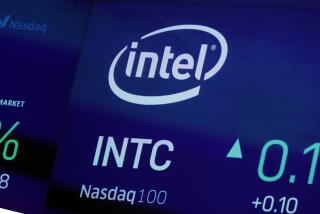Motorola to Slash 9,400 Jobs, Shutter 4 Plants
- Share via
Reeling telecommunications giant Motorola Inc. said Tuesday that it will fire 9,400 more workers over the next year and shed four more semiconductor plants to help it return to profitability.
The company’s action reflects continuing doldrums in a number of high-tech markets that may not have hit bottom yet and may not recover much next year, if at all, industry analysts said.
“We have not seen the semiconductor industry turn around yet, and we’re not going to see a turn-around next year in [wireless] base station equipment and cable modems,” said Edward F. Snyder, a J.P. Morgan analyst in San Francisco.
In another sign of the industry’s malaise, electronic products maker Toshiba Corp. said Tuesday that it is selling its U.S. chip manufacturing operation in Virginia to Micron Technology Inc. amid a recent plunge in prices, and is getting out of the business of producing memory chips for PCs.
Motorola’s layoffs will have the greatest effect on its semiconductor business, where 4,000 employees will lose their jobs. The wireless equipment manufacturing business, which builds networks and cell-phone base stations, will lose about 1,300 workers. The rest will come from operations companywide. The company would not say which plants it will close.
The cost-cutting is expected to save the long-troubled Schaumburg, Ill., company $865 million next year and about $1.1 billion a year after that.
Since its employment peaked 18 months ago at 150,000, Motorola has cut a total of 42,900 workers and has shipped 5,500 others to corporations that have purchased its businesses or facilities. Overall, Motorola has reduced its work force 32% from the peak.
Some analysts, however, criticized Motorola for reacting too slowly to changing times. “It’s a big company, not particularly nimble and not doing a good job forecasting where it’s going,” said Dale R. Pfau, an analyst at CIBC World Markets in San Francisco.
Christopher B. Galvin, Motorola’s chairman, said in a statement that the continuing layoffs, while regrettable, are necessary for a “leaner, more flexible and more profitable company” in an unpredictable global environment.
Executives told analysts in a conference call that the company would likely return to profitability in the third quarter next year and post an operating profit of 15 cents a share for the entire year. This year, however, it lost $2.7 billion in the first nine months, and will post an annual loss for the first time in nearly half a century. Executives reaffirmed their forecast for an operating loss of 4 to 5 cents a share for the last three months this year.
One bright spot for Motorola is its cellular telephone handset business, which is showing stronger sales than expected.
Incoming President Edward Breen said the company hopes to boost its share of mobile-phone sales to 25% of the market, a level Motorola last achieved for a full year in 1996 before Nokia surpassed the company.
“We expect to continue market share gains next year,” Breen said. But he didn’t say how long it would take to reach the target.
In the third quarter, Motorola’s mobile-phone market share was 15%, compared with Nokia’s 32%, according to researcher Gartner Inc.’s Dataquest Inc. unit.
But consultant Alan Reiter of Wireless Internet & Mobile Computing questions whether companies can grow much more without some blockbuster technology. Makers have penetrated 50% to 70% of the European market and about 50% of the U.S. market, making replacement more a factor than bringing in new customers.
“Most people buy cell phones for wireless voice. But what do you do after you’ve done that,” Reiter said. Efforts to build Internet access and other services into mobile phones has not gone over well with consumers, partly because of slow Internet speeds and tiny screens.
Motorola also is paying the price for past mistakes, such as producing too many phone styles without making any that are “exciting,” Reiter said.
For some analysts, the tech giant, which logged $37.6 billion in sales last year, tries to do too much. Sales of handsets and pagers account for 35% of its business, telecommunications equipment business garnering 21% and semiconductor products 16%. But it also makes two-way radio products for emergency personnel (12%) and high-speed communications products and cable modems (9%).
“For Motorola to do well and for its stock to do well, it has to have all the various segments working well,” said analyst Pfau.
“But even in 2000, when everyone had a good year, Motorola couldn’t get it right then because its handset business wasn’t clicking,” he said. “They’re always out of phase with something.”
The company released its news after the stock market closed. Motorola shares gained 34 cents to close at $16.61 on the New York Stock Exchange. They jumped as high as $17.95 in after-hours trading. Motorola’s stock still is down 18% this year.
Meanwhile, Toshiba joined other Japanese companies in departing the memory chip business. It plans to sell Dominion Semiconductor, a wholly owned subsidiary that makes dynamic random access memory (DRAM) chips in Manassas, Va., to Micron Technology in Boise, Idaho, by the end of January. Terms were not disclosed.
Micron, the world’s second-largest memory chip maker, said it is committed to strengthening its business in the face of the industry downturn.
The global slump and diving chip prices already led Fujitsu Ltd. to pull out of making DRAM chips. The only major DRAM production left among the Japanese makers is a joint venture between NEC Corp. and Hitachi Ltd.
More to Read
Inside the business of entertainment
The Wide Shot brings you news, analysis and insights on everything from streaming wars to production — and what it all means for the future.
You may occasionally receive promotional content from the Los Angeles Times.










